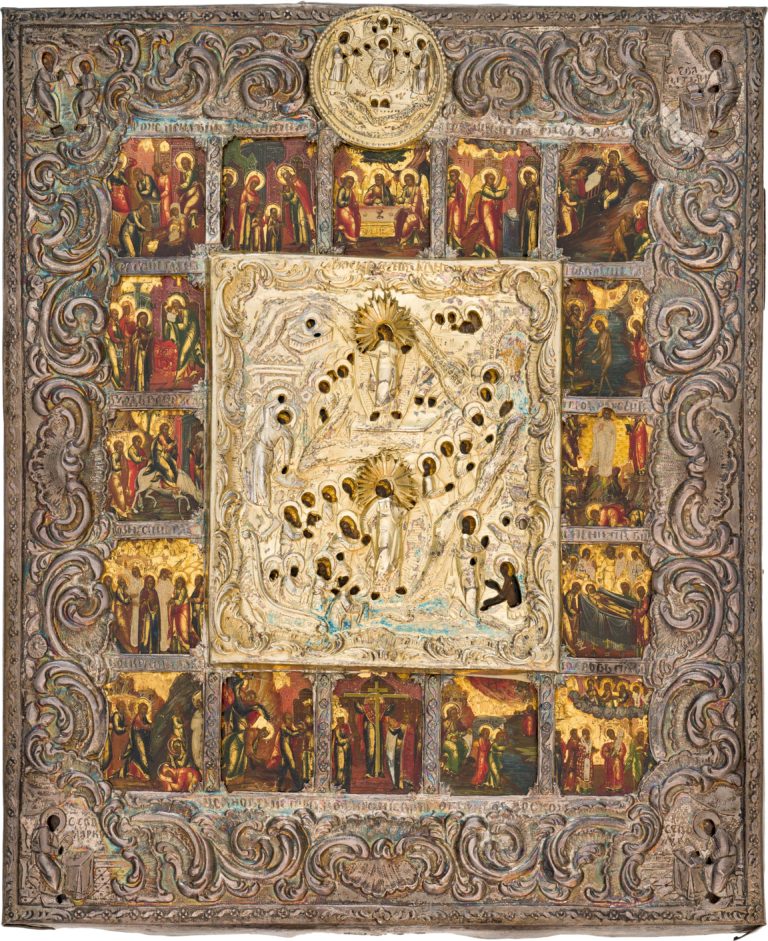The Resurrection – The Harrowing of Hades, with the Monogenis, the Church Feasts, and the Four Evangelists in 16 border scenes
The Resurrection – The Harrowing of Hades, with the Monogenis, the Church Feasts, and the Four Evangelists in 16 border scenes
Antique Russian icon: 1840s. Palekh (?).
Oklad cover: 1849. St. Petersburg.
Size: 27 х 22 х 2 cm
Wood (two panels), two incut, profiled support boards, absence of the incut centerpiece, underlying layer of gesso is not visible, gesso, tempera.
Oklad cover: silver, embossing, engraving, chasing, selective gilding.
Brands on the oklad cover: St. Petersburg coat-of-arms (1818–1864); silver hallmark “84;” “Д·Т / 1849” – the brand of the assayer Dmitriy Ilich Tverskoy (1832–1850); “Ф.Ф” in the rectangular shield – most likely, the official brand of the master silversmiths Faber Friedrich (born 1802).
Small fallouts and chafing of paint. Restoration tonings are minor. The oklad cover is in an overall good state.
Contact us

The Resurrection – The Harrowing of Hades, with the Monogenis, the Church Feasts, and the Four Evangelists in 16 border scenes
Diagram of the border scenes:
Diagram of the border scenes:
- The Nativity of the Mother of God;
- The Entrance of the Mother of God into the Temple;
- The Old Testament Trinity;
- The Annunciation;
- The Nativity of Christ;
- Candlemas (The Meeting of Christ in the Temple);
- The Theophany (The Baptism of Christ);
- The Entrance into Jerusalem;
- The Transfiguration;
- The Ascension;
- The Dormition of the Mother of God;
- The Raising of Lazarus;
- The Beheading of John the Baptist;
- The Elevation of the Holy Cross;
- The Fiery Ascent of the Prophet Elias;
- The Pokrov (Feast of the Protective veil of the Mother of God);
- The Monogenis;
- The Evangelist John the Theologian;
- The Evangelist Matthew;
- The Evangelist Mark;
- The Evangelist Luke.
Eastern Orthodox icons depicting “The Resurrection – the Harrowing of Hades” scene surrounded by the Twelve Great and Minor Feasts were highly popular in the 18th and 19th centuries. This is exactly the reason why the production of this type of hand-painted icons was put on stream, and the masters were ready to meet the taste preferences and financial capabilities of any commissioner. A large number of these religious icon paintings were created by Palekh iconographers who had standardized the performance techniques and developed several different religious icon schemes. The centerpiece of such antique Russian icons usually contains the detailed iconography of the Resurrection of Christ, with the Rising from the Tomb and the Harrowing of Hades scenes placed along a single axis and connected by a diagonal processional line of the Pious marching from the Gates of Hell to the Kingdom of Heaven. This composition is surrounded by other scenes that took place before or after the Resurrection. Their number depends on the religious icon’s size, as well as on the iconographer’s artistry and attention to detail. The given antique Russian icon includes the minimum number of centerpiece scenes: in the upper left corner, we see the “Apostle Peter at the Empty Tomb” scene, in the lower right – “The Revelation of Christ to the Apostles on the Sea of Galilee.” The centerpiece of the religious icon is surrounded by the traditional cycle of 16 border scenes. The described iconography is distinguished by the inclusion of “The Only Begotten Son” scene (Monogenis), placed in the medallion, into the center of the upmost tier. It gives the illustration of the troparion to the Church teaching on the Economy of Salvation, “Only-Begotten Son and Word of God, Immortal as You are, You condescended for our salvation to be incarnate of the Holy Theotokos and Ever-Virgin Mary and without undergoing change You became man. You were crucified O Christ God and You trampled death by Your death. You who are one of the Holy Trinity, Equal in glory with the Father and the Holy Spirit, Save us!” The inclusion of this scene and its emphasized, dominant position give the whole religious icon composition a clear eschatological character, which was quite typical for the Old Believers subjected to constant harassment.
Stylistic traits of the given antique Russian icon, the miniature manner of painting, the subtle, slightly dark color pallet, and the dry gold hatching on the vestments are all typical for the traditionalist movement in Russian icon art popular in the second quarter of the 19th century when many religious icon painters tried to imitate Palekh masters but in a rather simplified manner. Such hand-painted Orthodox icons were especially popular with the Old Believers, who commissioned them both, in Palekh and in other “imitation-prone” centers, which makes their attribution increasingly complicated.
The silver embossed oklad cover for this antique Russian icon was executed in the Second Baroque style in St. Petersburg in 1849. It is distinguished by certain splendor and pompousness, which were typical for the eclectic thinking of that era. The Baroque heaviness is clearly seen in the rich pattern consisted of lavish leaves and different curls with tracery borders. The master’s skillful use of various finishes – polished and chased surfaces – creates a wonderful play of light and shade, thus enhancing the dynamism of the ornament. The religious icon centerpiece is connected to the oklad with metal strips placed around the border scenes. Such a precious framing emphasizes the miniature manner of painting holy icons and gives colors brightness and sonority, creating the impression of valuable enamel inserts adorning the oklad fields.